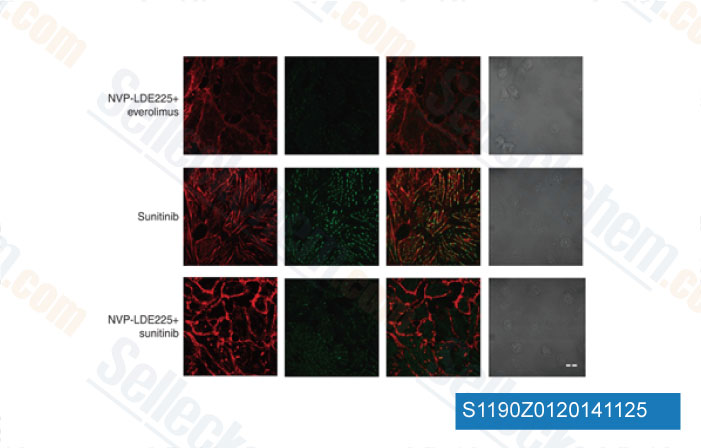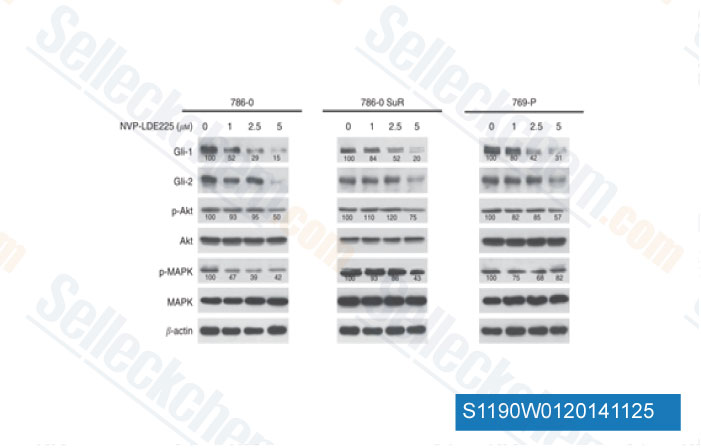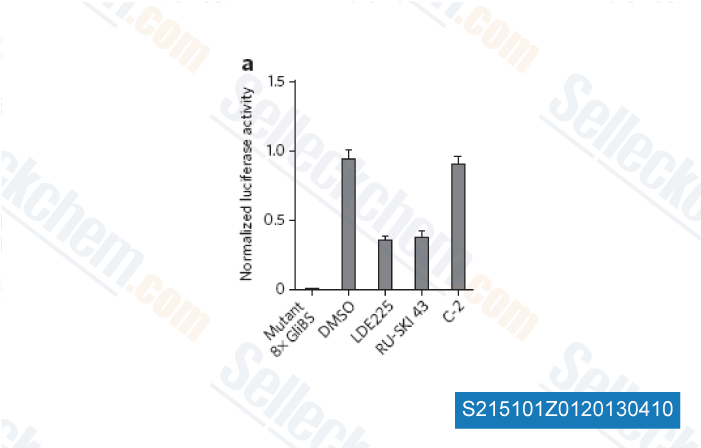|
Toll Free: (877) 796-6397 -- USA and Canada only -- |
Fax: +1-832-582-8590 Orders: +1-832-582-8158 |
Tech Support: +1-832-582-8158 Ext:3 Please provide your Order Number in the email. |
Technical Data
| Formula | C26H26F3N3O3 |
||||||
| Molecular Weight | 485.5 | CAS No. | 956697-53-3 | ||||
| Solubility (25°C)* | In vitro | DMSO | 97 mg/mL (199.79 mM) | ||||
| Ethanol | 48 mg/mL (98.86 mM) | ||||||
| Water | Insoluble | ||||||
| In vivo (Add solvents to the product individually and in order) |
|
||||||
|
* <1 mg/ml means slightly soluble or insoluble. * Please note that Selleck tests the solubility of all compounds in-house, and the actual solubility may differ slightly from published values. This is normal and is due to slight batch-to-batch variations. * Room temperature shipping (Stability testing shows this product can be shipped without any cooling measures.) |
|||||||
Preparing Stock Solutions
Biological Activity
| Description | Sonidegib is a Smoothened (Smo) antagonist, inhibiting Hedgehog (Hh) signaling with IC50 of 1.3 nM (mouse) and 2.5 nM (human) in cell-free assays, respectively. Phase 3. | ||||
|---|---|---|---|---|---|
| Targets |
|
||||
| In vitro | Sonidegib (Erismodegib, NVP-LDE225) inhibits TM3 luciferized cell line with 0.6 nM and 8 nM, at the presence of 1 nM and 25 nM Hh agonist Ag1.5, respectively. [1] | ||||
| In vivo | Sonidegib (Erismodegib, NVP-LDE225) is highly bound to mouse, rat, and human plasma proteins (>99%) and moderately bound to dog and monkey plasma proteins (77 and 85%, respectively). LDE225 has high permeability (90.8% in man) in the PAMPA assay. LDE225 shows good oral bioavailability ranging from 69 to 102% in preclinical species when dosed in solution. LDE225 is a weak base with a measured pKa of 4.20 and exhibits relatively poor aqueous solubility. LDE225 demonstrates dose-related antitumor activity. At a dose of 5 mg/kg/day qd, LDE225 significantly inhibits tumor growth, corresponding to a T/C value of 33%. When dosed at 10 and 20 mg/kg/day qd, LDE225 gives rise to 51 and 83% regression, respectively. Gli1 mRNA inhibition correlates with tumor and plasma exposure of LDE225. LDE225 successfully penetrates the blood−brain barrier in tumor-bearing animals and results in tumor growth inhibition after 4 days of treatment. [1] LDE225 significantly reduces the tumor volume by 95.7% in Rip1-Tag2 mice. LDE225 prolongs survival in Rip1Tag2 mice. LDE225 decreases expression of stromal markers in the LDE225-treated mice. [2] |
Protocol (from reference)
| Cell Assay: |
|
|---|---|
| Animal Study: |
|
References
|
Customer Product Validation

-
Data from [ Br J Cancer , 2014 , 111(6), 1168-79 ]

-
Data from [ Br J Cancer , 2014 , 111(6), 1168-79 ]

-
Data from [ Nat Chem Biol , 2013 , 9, 247-9 ]
Selleck's Sonidegib Has Been Cited by 74 Publications
| Sonic hedgehog medulloblastomas are dependent on Netrin-1 for survival [ Nat Commun, 2025, 16(1):5137] | PubMed: 40461501 |
| The O-glycosyltransferase C1GALT1 promotes EWSR1::FLI1 expression and is a therapeutic target for Ewing sarcoma [ Nat Commun, 2025, 16(1):1267] | PubMed: 39894896 |
| Determination of the Minimum Cell-to-Cell Adhesion Time Using Optical Tweezers in Leukemia and Lymphoma Research [ Method Protocol, 2025, 8(3)59] | PubMed: 40559447 |
| Identification of a distal enhancer regulating hedgehog interacting protein gene in human lung epithelial cells [ EBioMedicine, 2024, 101:105026] | PubMed: 38417378 |
| Inhibition of primary cilia-hedgehog signaling axis triggers autophagic cell death and suppresses malignant progression of VHL wild-type ccRCC [ Cell Death Dis, 2024, 15(10):739] | PubMed: 39389955 |
| Hedgehog signalling is involved in acquired resistance to KRASG12C inhibitors in lung cancer cells [ Cell Death Dis, 2024, 15(1):56] | PubMed: 38225225 |
| Alterations of ceramide synthesis induce PD-L1 internalization and signaling to regulate tumor metastasis and immunotherapy response [ Cell Rep, 2024, 43(8):114532] | PubMed: 39046874 |
| Genome-wide CRISPR-Cas9 knockout screens identify DNMT1 as a druggable dependency in sonic hedgehog medulloblastoma [ Acta Neuropathol Commun, 2024, 12(1):125] | PubMed: 39107797 |
| Genome-wide CRISPR-Cas9 knockout screens identify DNMT1 as a druggable dependency in sonic hedgehog medulloblastoma [ Acta Neuropathol Commun, 2024, 12(1):125] | PubMed: 39107797 |
| Patient-derived rhabdomyosarcoma cells recapitulate the genetic and transcriptomic landscapes of primary tumors [ iScience, 2024, 27(10):110862] | PubMed: 39319271 |
RETURN POLICY
Selleck Chemical’s Unconditional Return Policy ensures a smooth online shopping experience for our customers. If you are in any way unsatisfied with your purchase, you may return any item(s) within 7 days of receiving it. In the event of product quality issues, either protocol related or product related problems, you may return any item(s) within 365 days from the original purchase date. Please follow the instructions below when returning products.
SHIPPING AND STORAGE
Selleck products are transported at room temperature. If you receive the product at room temperature, please rest assured, the Selleck Quality Inspection Department has conducted experiments to verify that the normal temperature placement of one month will not affect the biological activity of powder products. After collecting, please store the product according to the requirements described in the datasheet. Most Selleck products are stable under the recommended conditions.
NOT FOR HUMAN, VETERINARY DIAGNOSTIC OR THERAPEUTIC USE.
